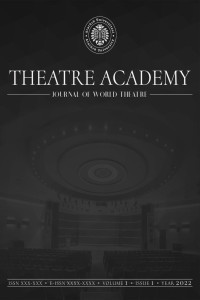“Işıktan kaçıp bile isteye sürgün ederler kendilerini”: William Shakespeare’in Bir Yaz Gecesi Rüyası’nda Mekânda, Sahnede ve Metatiyatroda Sürgün
Sürgün, William Shakespeare’in Bir Yaz Gecesi Rüyası adlı oyununun bütününde karşımıza çıkar. Dönüşen karakterler şekil değiştirdiklerinde insan dünyasından sürgün edilirler. Diğerleri ise büyülü dünyalara girmek için kendi ülkelerini ve dünyalarını terk etmek zorunda kalırlar. Kişilikler ve duygular büyü sayesinde değişir. Atina ile orman arasındaki ikilemi ve teatral dönüşümleri incelemek sürgünün coğrafi, duygusal ve mekânsal olduğunu gösterir. Sürgün aynı zamanda göçebe bir boyuta sahiptir. Oyundaki metatiyatronun incelenmesi, sürgün boyutunun varlığını desteklemektedir. Son olarak, Nathaniel C. Leonard ve Robert Weimann’ın platea, locus, meta-platea ve meta-locus gibi temel kavramlarının Bir Yaz Gecesi Rüyası’na uygulanması, Dramatik Katmanlama Spektrumu’nun sürgün tezahürlerini barındırdığı sonucuna ulaşmamızı sağlar. Bu araştırma, semantik incelemeleri tiyatro göstergebilimi ile birleştirmektedir. Sürgün meselesini hem edebiyat hem de tiyatro çalışmalarının merceğinden ele almak, oyunun ayrıntılarını ve karmaşıklıklarını anlamak için daha geniş perspektifler sunmaktadır.
Anahtar Kelimeler:
Metatiyatro, Sürgün, Dönüşüm, Bir Yaz Gecesi Rüyası, Shakespeare, Mise En Abyme, Dramatik Katmanlama Spektrumu
“They willfully themselves exile from light”: Exile in Space, Stage and Metatheatre in William Shakespeare’s A Midsummer Night’s Dream
Exile runs throughout William Shakespeare’s A Midsummer Night’s Dream. Transformed characters are exiled from the human world when they change shapes. Others are forced to leave their countries and worlds to enter magical ones. Personalities and feelings shift because of magic. Examining the dichotomy between Athens and the forest and the theatrical transformations shows that exile is geographical, emotional and spatial. Exile is also endowed with a transmigrant dimension. The study of metatheatre in the play corroborates the presence of an exilic dimension. Finally, the application of Nathaniel C. Leonard’s and Robert Weimann’s fundamental notions of platea, locus, meta-platea, and meta-locus in A Midsummer Night’s Dream enables us to reach the finding that the Spectrum of Dramatic Layering hosts exilic manifestations. The research merges semantic investigations with the semiotics of theatre. Dealing with the matter of exile both from the lenses of literary and theatrical studies offers broader perspectives to understand the play’s nuances and complexities.
Keywords:
metatheatre, exile, A Midsummer Night's Dream, transformation, mise en abyme, Spectrum of Dramatic Layering,
___
- Alter, J. (1990). Transformational Processes: Production/Reception. In A Sociosemiotic Theory of Theatre (pp. 149–230). University of Pennsylvania Press. http://www.jstor.org/stable/j.ctv4t811z.7
- Alter, J. (1990). Playwrights, Directors, Actors, and Their Work. In A Sociosemiotic Theory of Theatre (pp. 231–270). University of Pennsylvania Press. http://www.jstor.org/stable/j.ctv4t811z.8
- Barton, A. (2017). The Shakespearean forest. Cambridge University Press.
- Ben Amor, Z. (2003). When Doctor Faustus Fails, Irony Prevails: The Spectacle of Blindness in Christopher Marlowe’s The Tragical History of Doctor Faustus. English Studies Series, 3, 116-126.
- Ben Amor, Z. (2020). Mapping Sight and Blindness in King Lear(s) of William Shakespeare and Roberto Ciulli: Towards a Poly-optic Reading. International Review of Literary Studies, 2(2), 10–23. Retrieved from http://irlsjournal.com/ojs/index.php/irls/article/view/21
- Ben Amor, Z. (2022). ‘Santiago Matamoros’ or Saint James the Moor Killer: Who Wants to Kill the Moor in William Shakespeare’s Othello? Eurasian Journal of English Language and Literature, vol. 4, no. 2, Nov. 2022, pp. 144–74. dergipark.org.tr, https://dergipark.org.tr/en/pub/jell/issue/73334/1124745.
- Cadel, F. (2006). Exile: Interview with Toni Negri. Rethinking Marxism, 18(3), 353–366. https://doi.org/10.1080/08935690600747985
- Evelein, J. F. (2021). Brecht and Exile. In S. Brockmann (Ed.), Bertolt Brecht in Context (pp. 89–96). Chapter, Cambridge: Cambridge University Press. http://doi.org/10.1017/9781108608800.013
- Homer, Fagles, R., & Homer. (1997). The Odyssey. Penguin.
- Krueger, A. (2011). A white man in exile: The failure of masculinity in Athol Fugard’s Sorrows and Rejoicings. South African Theatre Journal, 25(2), 119–128. https://doi.org/10.1080/10137548.2011.636974
- Leonard, N. C. (2013.). The Reflexive Scaffold: Metatheatricality, Genre, and Cultural Performance in English Renaissance Drama. https://doi.org/10.7275/2K8X-0X71
- Leonard, N.C. (2018). All ‘Metatheatre’ is Not Created Equal: The Knight of the Burning Pestle, A Midsummer Night’s Dream, and the Navigation of the Spectrum of Dramatic Representation. Shakespeare Bulletin 36(1), 49-67. doi:10.1353/shb.2018.0004.
- Lin, E. T. (2009). Popular Festivity and the Early Modern Stage: The Case of George a Greene. Theatre Journal, 61(2), 271–297. http://www.jstor.org/stable/40587393
- MacLean, S. B. (1989). Drama and ceremony in early modern England: the REED project. Urban History Yearbook, [16], 38–46. http://www.jstor.org/stable/44610110
- Ovid, Green, P., Ovid, & Ovid. (2005). The poems of exile: Tristia and the Black Sea letters. University of California Press.
- Said, E. W. (2002). Reflections on exile and other essays (1. paperback ed). Harvard Univ. Press. Shakespeare, W. (2014). The tragedy of hamlet, prince of Denmark (B. A. Mowat & P. Werstine, Eds.; Updated edition). Simon & Schuster Paperbacks. (Original work published 1603).
- Shakespeare, W. (2016). A midsummer night’s dream (B. A. Mowat & P. Werstine, Eds.; Updated edition.
- Simon&Schuster paperback edition). Simon & Schuster Paperbacks. (Original work published 1600).
- Shakespeare, W. (2016). The tempest (B. A. Mowat & P. Werstine, Eds.; Simon & Schuster paperback edition January 2016). Simon & Schuster Paperbacks. (Original work published 1611).
- Shakespeare, W., Mowat, B. A., & Werstine, P. (2019). Twelfth night, or, What you will. Simon & Schuster Paperbacks. (Original work published 1602).
- Shakespeare, W., Mowat, B. A., & Werstine, P. (2019). As you like it (An updated edition). Simon & Schuster Paperbacks. (Original work published 1600).
- Theis, J. S. (2009). Writing the forest in early modern England: A sylvan pastoral nation. Duquesne University Press.
- Weimann, R., & Weimann, R. (1987). Shakespeare and the popular tradition in the theater: Studies in the social dimension of dramatic form and function (R. Schwartz, Ed.; Johns Hopkins paperback ed). Johns Hopkins Univ. Press.
- Wheatley, D. (2012). Samuel Beckett: Exile and Experiment. Oxford University Press. https://doi.org/10.1093/oxfordhb/9780199561247.013.0009
- Young, D. (1972). The heart’s forest: A study of Shakespeare’s pastoral plays. Yale University Press.
- Başlangıç: 2023
- Yayıncı: Atatürk Üniversitesi
